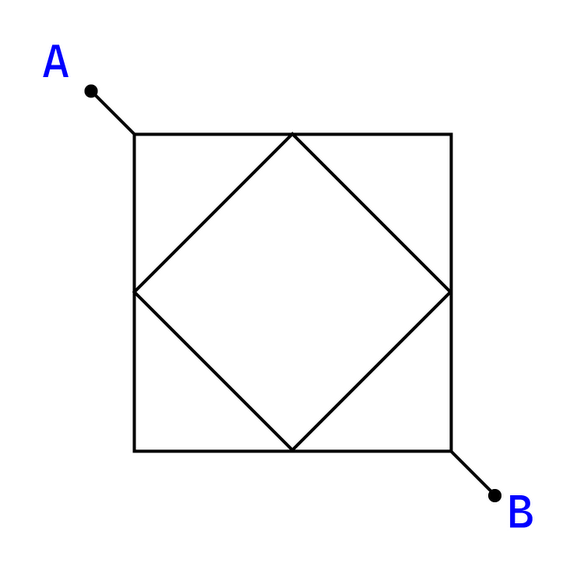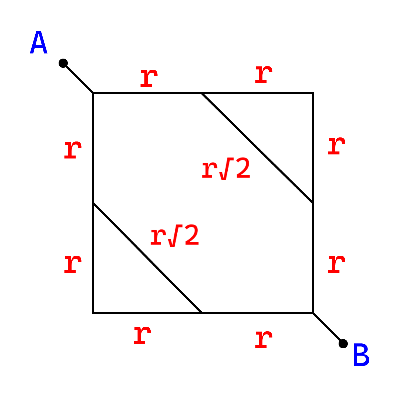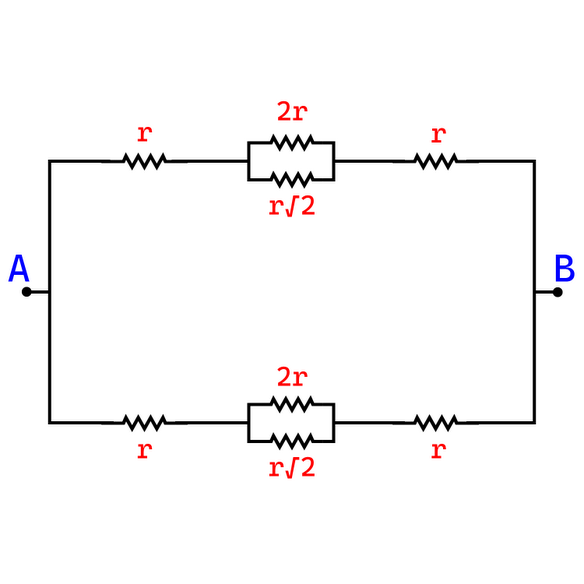
A wire has linear resistance $\rho$(in Ohm/m). Find the resistance r between points A and B if the side of the larger square is ‘d’.

A) $\dfrac{\rho d}{\sqrt2}$
B) $\sqrt2\rho d$
C) $2rd$
D) None of these
Answer
220.5k+ views
Hint:The problem is from the electricity part of physics. We can apply the concept of parallel combination and series combination of resistance here. Use the equation for effective resistance in parallel and series combinations.
Formula Used:
Equivalent resistance for a series resistance circuit:
${R_E} = {R_1} + {R_2} + {R_3}$
Equivalent resistance for a parallel resistance circuit:
$\dfrac{1}{{{R_E}}} = \dfrac{1}{{{R_1}}} + \dfrac{1}{{{R_2}}} + \dfrac{1}{{{R_3}}}$
Where ${R_E}$= equivalent resistance and ${R_1},{R_2},{R_3}$ = component resistance.
Complete answer:
The equivalent resistance is a single resistance which can replace all the component resistances in a circuit in such a manner that the current in the circuit remains unchanged.

Figure 1
Let’s half side of the resistor is r. Where $r = \dfrac{{\rho d}}{2}$
We can redraw the circuit diagram and it will be.

Figure 2
Apply the equations for parallel and series combinations and the equivalence resistance is calculated as,
${R_E} = \dfrac{1}{2}\left[ {2r + \dfrac{{2r \times r\sqrt 2 }}{{2r + r\sqrt 2 }}} \right] = \dfrac{1}{2}\left[ {2r + \dfrac{{2r \times r\sqrt 2 }}{{(2 + \sqrt 2 )r}}} \right]$
${R_E} = \dfrac{1}{2}\left[ {\dfrac{{2r \times (2 + \sqrt 2 )r + 2{r^2}\sqrt 2 }}{{(2 + \sqrt 2 )r}}} \right]$
${R_E} = \dfrac{1}{2}\left[ {\dfrac{{4r + 2r\sqrt 2 + 2r\sqrt 2 }}{{2 + \sqrt 2 }}} \right]$
${R_E} = \dfrac{1}{2}\left[ {\dfrac{{4r\sqrt 2 + 4r}}{{2 + \sqrt 2 }}} \right]$
${R_E} = \dfrac{{4r}}{2}\dfrac{{\sqrt 2 + 1}}{{2 + \sqrt 2 }} \times \dfrac{{2 - \sqrt 2 }}{{2 - \sqrt 2 }}$
${R_E} = 2r\left( {\dfrac{{2\sqrt 2 - {{(\sqrt 2 )}^2} + 2 - \sqrt 2 }}{{{2^2} - {{(\sqrt 2 )}^2}}}} \right)$
${R_E} = 2r\dfrac{{\sqrt 2 }}{2} = r\sqrt 2 $
Substituting the value of r and the ${R_E}$will become,
\[{R_E} = \dfrac{{\rho d\sqrt 2 }}{2} = \dfrac{{\rho d}}{{\sqrt 2 }}\]
Hence, the correct option is Option (A).
Note: Resistance is a measure of the opposition to current flow in an electrical circuit. Resistance blocks the flow of current. The S.I unit of resistance is ohms. The current decreases as resistance increases. On the other hand, the current increases as the resistance decreases. While solving this one also has to pay close attention to the connection between resistances.
Formula Used:
Equivalent resistance for a series resistance circuit:
${R_E} = {R_1} + {R_2} + {R_3}$
Equivalent resistance for a parallel resistance circuit:
$\dfrac{1}{{{R_E}}} = \dfrac{1}{{{R_1}}} + \dfrac{1}{{{R_2}}} + \dfrac{1}{{{R_3}}}$
Where ${R_E}$= equivalent resistance and ${R_1},{R_2},{R_3}$ = component resistance.
Complete answer:
The equivalent resistance is a single resistance which can replace all the component resistances in a circuit in such a manner that the current in the circuit remains unchanged.

Figure 1
Let’s half side of the resistor is r. Where $r = \dfrac{{\rho d}}{2}$
We can redraw the circuit diagram and it will be.

Figure 2
Apply the equations for parallel and series combinations and the equivalence resistance is calculated as,
${R_E} = \dfrac{1}{2}\left[ {2r + \dfrac{{2r \times r\sqrt 2 }}{{2r + r\sqrt 2 }}} \right] = \dfrac{1}{2}\left[ {2r + \dfrac{{2r \times r\sqrt 2 }}{{(2 + \sqrt 2 )r}}} \right]$
${R_E} = \dfrac{1}{2}\left[ {\dfrac{{2r \times (2 + \sqrt 2 )r + 2{r^2}\sqrt 2 }}{{(2 + \sqrt 2 )r}}} \right]$
${R_E} = \dfrac{1}{2}\left[ {\dfrac{{4r + 2r\sqrt 2 + 2r\sqrt 2 }}{{2 + \sqrt 2 }}} \right]$
${R_E} = \dfrac{1}{2}\left[ {\dfrac{{4r\sqrt 2 + 4r}}{{2 + \sqrt 2 }}} \right]$
${R_E} = \dfrac{{4r}}{2}\dfrac{{\sqrt 2 + 1}}{{2 + \sqrt 2 }} \times \dfrac{{2 - \sqrt 2 }}{{2 - \sqrt 2 }}$
${R_E} = 2r\left( {\dfrac{{2\sqrt 2 - {{(\sqrt 2 )}^2} + 2 - \sqrt 2 }}{{{2^2} - {{(\sqrt 2 )}^2}}}} \right)$
${R_E} = 2r\dfrac{{\sqrt 2 }}{2} = r\sqrt 2 $
Substituting the value of r and the ${R_E}$will become,
\[{R_E} = \dfrac{{\rho d\sqrt 2 }}{2} = \dfrac{{\rho d}}{{\sqrt 2 }}\]
Hence, the correct option is Option (A).
Note: Resistance is a measure of the opposition to current flow in an electrical circuit. Resistance blocks the flow of current. The S.I unit of resistance is ohms. The current decreases as resistance increases. On the other hand, the current increases as the resistance decreases. While solving this one also has to pay close attention to the connection between resistances.
Recently Updated Pages
Mass vs Weight: Key Differences Explained for Students

Young’s Double Slit Experiment Derivation Explained

Electricity and Magnetism Explained: Key Concepts & Applications

JEE Energetics Important Concepts and Tips for Exam Preparation

JEE Isolation, Preparation and Properties of Non-metals Important Concepts and Tips for Exam Preparation

JEE Main 2021 July 25 Shift 1 Question Paper with Answer Key

Trending doubts
JEE Main 2026: Application Form Open, Exam Dates, Syllabus, Eligibility & Question Papers

Understanding Uniform Acceleration in Physics

Derivation of Equation of Trajectory Explained for Students

Hybridisation in Chemistry – Concept, Types & Applications

Understanding the Angle of Deviation in a Prism

How to Convert a Galvanometer into an Ammeter or Voltmeter

Other Pages
JEE Advanced Marks vs Ranks 2025: Understanding Category-wise Qualifying Marks and Previous Year Cut-offs

Dual Nature of Radiation and Matter Class 12 Physics Chapter 11 CBSE Notes - 2025-26

JEE Main Marking Scheme 2026- Paper-Wise Marks Distribution and Negative Marking Details

Degree of Dissociation: Meaning, Formula, Calculation & Uses

Ideal and Non-Ideal Solutions Explained for Class 12 Chemistry

Understanding the Electric Field of a Uniformly Charged Ring




